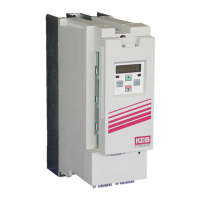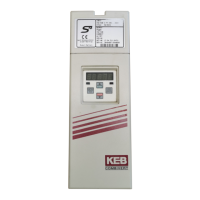6
411
KEB COMBIVERT F5-G / B
Name: Basis
06.02.02
6
© KEB Antriebstechnik, 2002
All rights reserved
Functional DescriptionSet Value and Ramp Adjustment
Section PageDate Chapter
+f [Hz]
-f [Hz]
400
oP.7*
1
(oP.6)
oP.6
oP.14
oP.10
oP.15*
1
(oP.14)
oP.11*
1
(oP.10)
+100
-100
-400
Absolute maximal
frequency reverse
6.4.5 Setpoint Limits
Following limit values can be preadjusted:
Setpoint[%]Setpoint[%]
Minimal frequency
forward
Maximal
frequency forward
Absolute maximal
frequency forward
Maximal frequency
reverse
Minimal frequency
reverse
*1 If the value „=For“ is adjusted in these parameters (limit values rotation direction
reverse), then the adjusted values for rotation direction forward (oP.6, oP.10
and oP.14) are valid.
In case of setpoint adjustment in percent the minimal and maximal frequencies
form the characteristic for the frequency calculation (0% = minimal frequency; 100%
= maximal frequency). In case of absolute setpoint adjustment the minimal and
maximal frequencies limit the setpoint. Separate limits can be adjusted for both
rotation directions. If the value „For“ is adjusted for rotation direction „Reverse“,
then the values for „Forward“ are valid.
Setting range: oP.6: 0...400 Hz Default: 0 Hz
oP.10: 0...400 Hz Default: 70 Hz
oP.7: =For, 0...400 Hz Default: =For
oP.11: =For, 0...400 Hz Default: =For
Minimal- / Maximal frequency
(oP.6, oP.7, oP.10, oP.11)
After the minimal and maximal frequencies the setpoint is limited through the abso-
lute maximal frequency and subsequently transferred to the ramp generator. Since
the analog setpoint is always calculated onto the maximal frequencies (oP.10,
oP.11), it is possible, to adjust the characteristic of the analog setpoint with the
same gain for both rotation directions (see Fig. 6.4.5.a) in spite of different maxi-
mal output frequencies. If the value „=For“ is adjusted in oP.15, then the absolute
maximal frequency of oP.14 is valid for both rotation directions.
Absolute maximal frequency
(oP.14, oP.15)
Fig. 6.4.5 Setpoint limits

